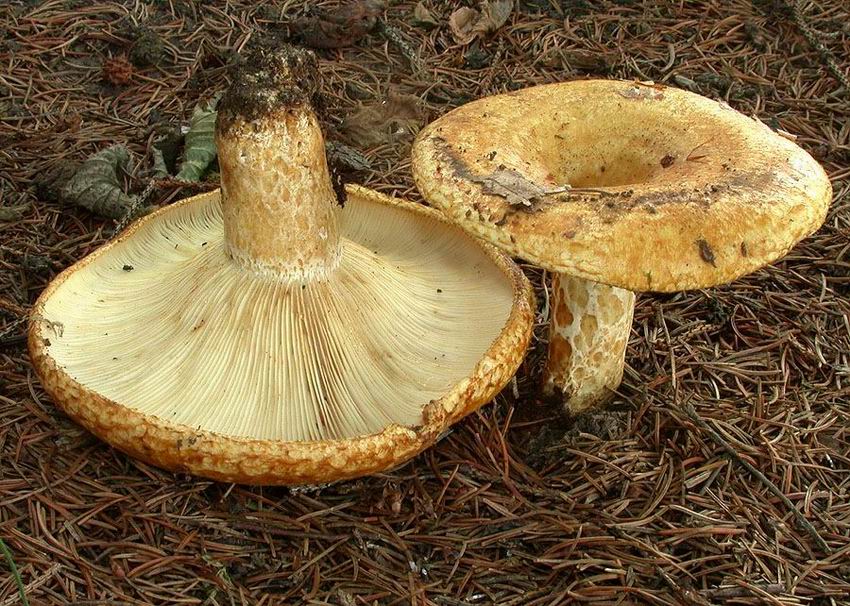- Lactarius scrobiculatus
Taxobox | name = "Lactarius scrobiculatus"

image_width = 240px
regnum = Fungi
divisio =Basidiomycota
class =Homobasidiomycetes
ordo =Russulales
familia =Russulaceae
genus = "Lactarius "
species = "L. scrobiculatus"
binomial = "Lactarius scrobiculatus"
binomial_authority = (Scop.) Fr. [http://www.indexfungorum.org/Names/NamesRecord.asp?RecordID=196637 Index Fungorum] mycomorphbox
name = Lactarius scrobiculatus
whichGills = decurrent
capShape = depressed
hymeniumType=gills
stipeCharacter=bare
ecologicalType=mycorrhizal
sporePrintColor=cream
howEdible=inedible"Lactarius scrobiculatus" is a basidiomycete fungus, belonging to the genus
Lactarius , whose members are called "milk caps." Taxonomy places this species into subgenus Piperites, section Zonarii, subsection Scrobiculati. [http://en.wikipedia.org/wiki/List_of_Lactarius_species] The distinctive fruiting bodies of this large, inedible fungus are locally common in forests throughout Europe and North America.Description
"Lactarius scrobiculatus" produces large
agaric oid fruiting bodies which arise from soil. The cap has an eye-catching orange to yellow coloration and is covered with small scales arranged in indistinctive concentric rings. The surface is wet, glossy and slimy especially in wet weather. The cap may be wide, with a large diameter (about 15 cm in mature specimens), but with a depressed centre and slightly inrolled margin. The gills are crowded and coloured cream to yellow, with darker patches being present sometimes. When cut, the gills bleed copious amounts of a white to cream milk (latex), which soon darkens to yellow. The stem, in relation to the cap, is quite short and stubby. The surface is cap-coloured but the presence of small pits, filled with fluid, is a key identifying feature. The stem is hollow. The spores are coloured creamy with an elliptical-globular shape. [cite book|last=Mabey|first=Richard|year=1993|title=Mushrooms & Toadstools of Britain and Europe|publisher=David & Charles|pages=106|id=ISBN 0-7153-0155-1]When a small piece of flesh is chewed, it tastes quite acrid. So acrid, that a researcher reportedly developed a numbness in the mouth, having nibbled on a piece.cite web | title=Poisonous and Hallucinogenic Mushrooms | publisher=The Evergreen State College, Olympia WA | url=http://academic.evergreen.edu/projects/mushrooms/phm/s60.htm | accessdate=June 14 | accessyear=2007] It doesn't have any discernible smell.
There are several recognised varieties, including var. "canadensis". var. "montanus" and var. "pubescens".cite web | title="Lactarius scrobiculatus" varieties | publisher=Russulales News | url=http://www.mtsn.tn.it/russulales-news/tx_results.asp?f_rank=all&f_genus=Lactarius&f_epithet=scrobiculatus&f_author=&f_from_year=&f_to_year= | accessdate=June 19 | accessyear=2007]
Distribution
This species is known throughout Europe, as well as North America where its occurrence is rare. [cite web | title=Rogers Mushrooms - "Lactarius scrobiculatus" | publisher=Rogers Mushrooms | url=http://www.rogersmushrooms.com/gallery/DisplayBlock~bid~6338.asp | accessdate=June 14 | accessyear=2007] It occurs primarily in
coniferous forest s where it forms amycorrhiza l relationship and appears to prefer damp, boggy areas. The fruibodies rarely occur singly — usually there are several more nearby. The fruiting season of "L. scrobiculatus" is summer to autumn.Edibility
"Lactarius scrobiculatus" is inedible and may even cause irritation to the
gastrointestinal tract . It is eaten ineastern Europe afterpickling or thorough cooking and even then, some might still experience distressing symptoms.References
Wikimedia Foundation. 2010.
